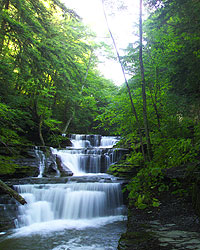
Nestled among the Ghosts of Glaciers
Cornell's location in the heart of New York's Finger Lakes region, with its beautiful lakes, waterfalls, rolling hills, farmland, vineyards, and state parks, is as striking now as it was in Ezra Cornell's time. The campus itself is one of the most attractive in the nation.
But Ithaca and the Tompkins County area offer much more than naturally beautiful surroundings. There is a blend of rural practicality, urban sophistication, and international flavor here that produces the warmth and friendliness of a small town combined with the rich cultural complexity of places many times larger.
Ithaca's past and settings have been chronicled in feature films, made-for-TV movies, and best-selling books. University students, staff, and faculty members make up a third of Tompkins County's population of 97,000, and support an amazing number and variety of bookstores and restaurants.

Cornell Outdoor Education offers virtually endless year-round opportunities to enjoy the region's natural attractions.
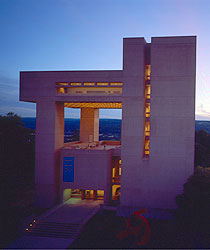
The Johnson Museum of Art charges no admission fee and, like Cornell's libraries, is open to the general public.
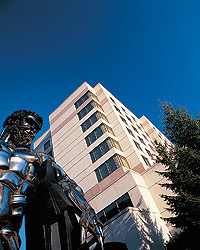
The Statler Hotel allows students to combine theory and practice at the world-renowned School of Hotel Administration.
"I loved the scenery, the hilly roads which were so characteristic of that part of the country, and the wonderful campus with its beautiful buildings and big trees."
S. C. Thomas (Tommy) Sze, Chinese railroad pioneer, Cornell class of 1905
Cornell sits on a hilltop overlooking 40-mile-long, 400-foot-deep Cayuga Lake, the longest of the Finger Lakes of central New York State. Two sides of the campus are bound by gorges, cut during the last 12,000 years. Creeks and waterfalls fill the gorges, and no matter where you are on campus you are never far from the sight and sound of falling water. This is an area of great natural beauty, a place that contributes to a healthy and pleasurable quality of life.
Perhaps the most remarkable feature of the Cornell campus is the seamless interconnection of nature and the built environment. Cornell Plantations, curator of the university's natural areas, maintains trails, arboretums, and gardens that intertwine and blend with the university's graceful quads and inspiring architecture.
Not only is Cornell a higher education and research powerhouse, we believe it is also one of the most spectacular university campuses anywhere in the world. Don't take our word for it, however. Visit us!
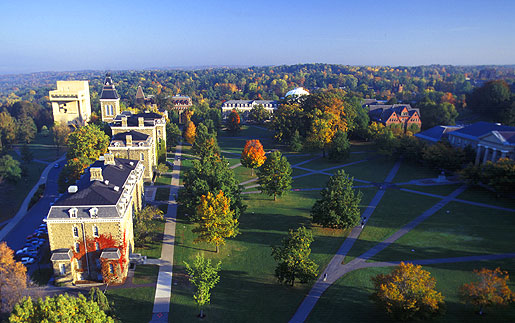
The paths students take to get to Cornell classes are as diverse as the paths students take after they graduate.
Profile
| Cornell University main campus: |
Ithaca, NY |
| Founded: |
1865 |
| Enrollment: |
19,639 |
| Undergraduate students: |
13,562 |
| Graduate and professional students: |
6,077 |
| Number of faculty: |
1,627 |
| Chief administrator |
President David J. Skorton |
Mission
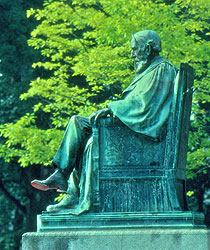
Cornell's first president, A. D. White, studied the great universities of his time to implement Ezra Cornell's vision of an inclusive and academically diverse institution.
Once called "the first American university" by a prominent educational historian, Cornell represents a distinctive mix of eminent scholarship and democratic ideals. Founded as both a private university and the land-grant institution of New York State, this distinctive blend of public and private colleges and programs continues to reflect a heritage of egalitarian excellence, making Cornell the most educationally diverse university in the Ivy League. In an inaugural address in October 2004, the first Cornell alumnus to become its president, Jeffrey Lehman, articulated a vision intended to make more history, projecting Cornell as "the transnational university of the future."
Campus
There are more than 260 major buildings on the 745 contiguous acres that comprise Cornell's flagship campus atop East Hill overlooking the city of Ithaca and the southern basin of Cayuga Lake. Widely admired as one of the world's most beautiful academic settings, the campus was once the family farm of the university's co-founder, Ezra Cornell.
Location
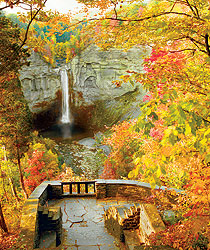
Taughannock Falls, minutes from campus, is higher than Niagara Falls and only one of many beautiful waterfalls in the area.
The Finger Lakes region of central New York is renowned for natural beauty with spectacular gorges and waterfalls that bracket the campus. Three state parks are within 10 miles. Popular outdoor activities include sailing, wind surfing, swimming, skiing, hiking, and picnicking.
The city of Ithaca and its surrounding residential areas have a population close to 100,000. There is a surprising array of bookshops, movie houses, specialty stores, nightspots, and restaurants, including many with ethnic cuisine.
Ithaca's international population is quite varied, with international students from 120 countries representing 15 percent of Cornell's enrollment. The city of Syracuse, the Finger Lakes wine district, the Watkins Glen auto racing circuit, and several centers for the performing arts are all within an hour's drive. New York City and Toronto are less than five hours away.
Programs
Students choose from among 4,000 courses in 11 undergraduate, graduate, and professional schools, including the nation's first colleges devoted to hotel administration, industrial and labor relations, and veterinary medicine. Many undergraduates participate in a wide range of interdisciplinary programs, play meaningful roles in original research, and study in Cornell programs in Washington, New York City, and the world over.
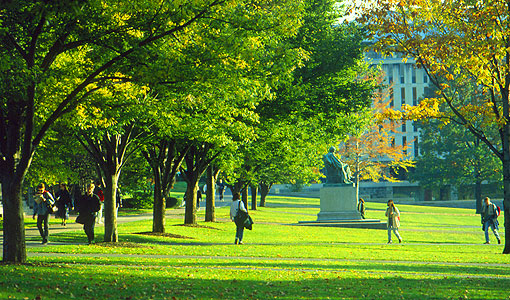
A.D. White, Cornell's first president, is immortalized in bronze opposite a statue of Ezra Cornell on the Arts Quad.








